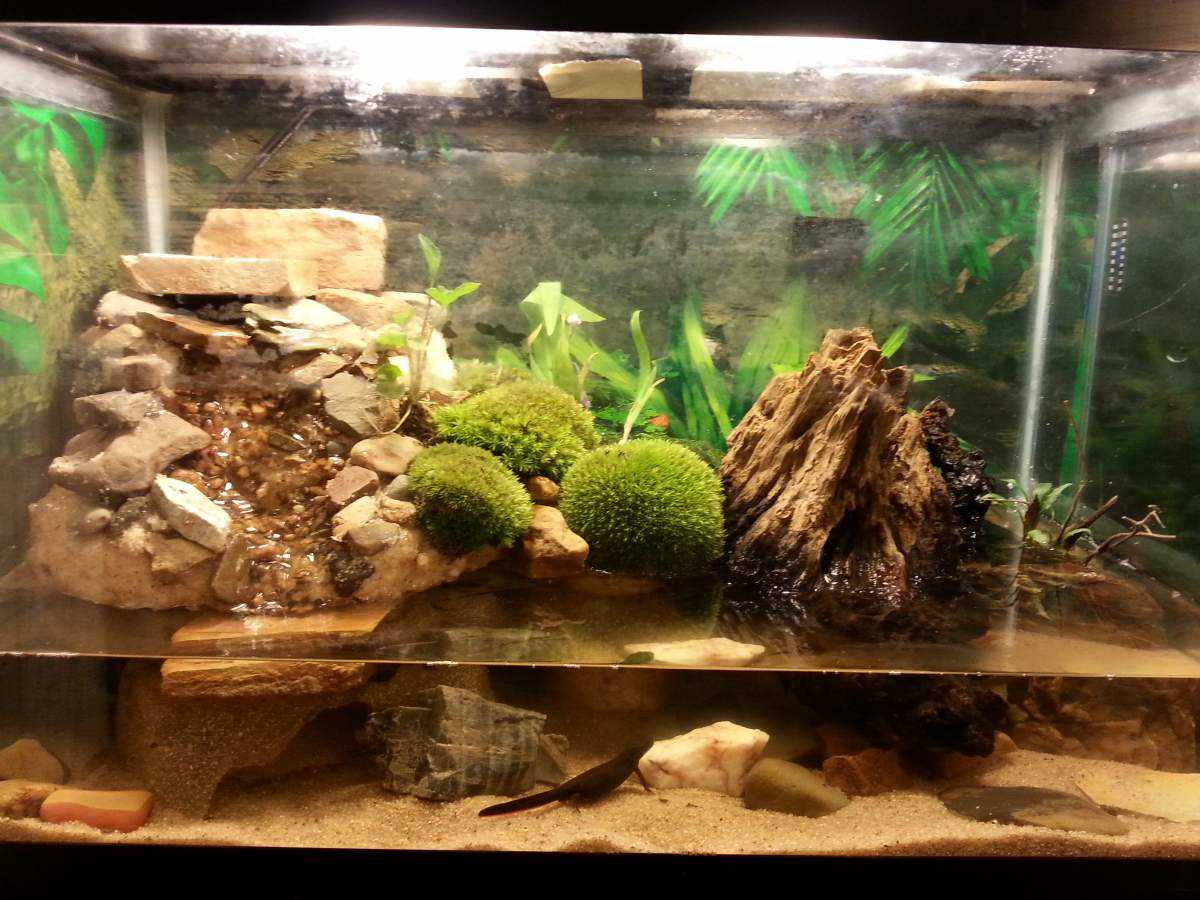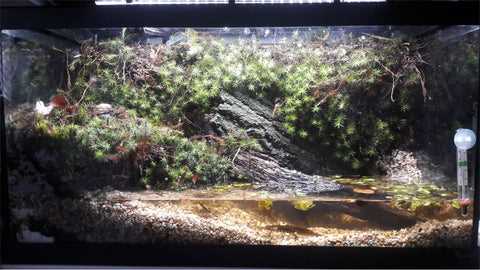
Care: Proper care is essential for the health and well-being of your newt. Newts require a well-maintained habitat with clean and dechlorinated water. The water temperature should be between 60 to 70°F (15 to 21°C), and pH levels should be kept neutral to slightly acidic. It’s crucial to regularly monitor the ammonia, nitrite, and nitrate levels to ensure a healthy aquatic environment.
Housing: Newts should be housed in an aquarium that mimics their natural habitat. A 20-gallon tank is recommended for a single newt, with an additional 10 gallons per additional newt. Provide plenty of hiding spots with rocks, plants, and driftwood, as newts are nocturnal and appreciate a secure hiding place during the day. Avoid using gravel as a substrate, as it can be ingested and cause health issues.
Tips: Here are some essential tips for keeping newts in an aquarium:
- Feeding: Newts are carnivores and thrive on a diet of live or frozen foods, such as bloodworms, brine shrimp, and small fish. Offer a varied diet to ensure they receive all necessary nutrients.
- Maintenance: Regularly clean the tank by removing any uneaten food and waste, and change a portion of the water weekly. Keep a close eye on the water quality and make any necessary adjustments to maintain a healthy environment.
- Handling: Limit handling your newt as much as possible, as excessive handling can cause stress and potentially harm them. If necessary, handle them with wet hands to avoid injuring their delicate skin.
- Observing: Spend time observing your newt’s behavior to learn its routine and habits. Newts are fascinating creatures to watch, especially during feeding time and when they explore their surroundings.
By following these care guidelines and providing a suitable habitat, you can ensure the well-being and happiness of your newt. Enjoy the experience of keeping these remarkable amphibians and marvel at their unique beauty!
Newt Care: A Comprehensive Guide
Aquarium Size: Newts require a minimum tank size of 10 gallons, but larger tanks are recommended for a more comfortable and stimulating environment. The size of the tank should be suitable for the number of newts you have and allow them enough space to swim and explore.
Material: The aquarium can be made of glass or acrylic. Glass tanks are more common and provide better insulation and stability. Acrylic tanks are lighter and less prone to cracking, but they may scratch more easily.
Shape: Rectangular tanks are the most practical and suitable for newts. They provide more surface area for swimming and allow for better placement of heaters, filters, and decorations.
Water Depth: Newts are semi-aquatic creatures and need both water and land areas in their aquarium. The water depth should be at least half the height of the tank, allowing the newts to fully submerge and swim comfortably.
Land Area: Create a land area in the tank by using rocks, driftwood, or plastic platforms. This area should be easily accessible from the water and provide a dry spot for the newts to rest, bask, and hide. Additionally, adding live or artificial plants can create a more natural and aesthetically pleasing habitat.
Lighting: Newts do not require special lighting, but they do benefit from a natural day-night cycle. Consider using a timer to provide 8-12 hours of light and 12-16 hours of darkness each day.
| Aquarium Requirements for Newts: |
|---|
| – Minimum tank size of 10 gallons |
| – Glass or acrylic material |
| – Rectangular shape |
| – Water depth of at least half the tank height |
| – Land area with rocks, driftwood, or platforms |
| – Filtration and heating system |
| – Natural day-night lighting cycle |
By providing a suitable aquarium for your newts, you can ensure their comfort and well-being. Remember to regularly clean the tank, monitor water parameters, and provide a balanced diet to keep your newts healthy and happy.
Choosing the Right Aquarium for Your Newts
Size
The size of the aquarium is an essential factor to consider. A larger tank is always better as it provides more swimming space for your newts. A minimum of a 20-gallon tank is recommended for a single newt, but if you plan to keep multiple newts, opt for an even larger tank.
Material

Choosing the right material for the aquarium is also important. Glass or acrylic tanks are the most popular choices and are both suitable for newts. Whichever material you choose, make sure it is durable, easy to clean, and doesn’t contain any toxic elements that could harm your newts.
Water Depth
Newts are amphibious creatures and need both land and water areas in their aquarium. The water depth should be sufficient for them to swim and explore. A depth of at least 6 inches is recommended to accommodate their natural behavior.
Land Area
Newts require a land area in their aquarium where they can rest and dry off. This can be achieved by adding rocks, driftwood, or plastic platforms to create a semi-aquatic environment. Make sure the land area is easily accessible from the water and provides a comfortable resting place for your newts.
Filtration
Proper filtration is crucial for maintaining a healthy aquarium for your newts. A good filtration system will help remove impurities from the water and keep the tank clean. Look for a filter that is appropriate for the size of your aquarium and ensure it provides both mechanical and biological filtration.
Heating and Lighting
Newts are ectothermic, which means they rely on external sources of heat to regulate their body temperature. Providing a suitable heating source, such as a submersible aquarium heater, is essential to maintain the water temperature within the recommended range for newts. Additionally, consider adding a UVB light to provide the necessary spectrum of light for your newts’ metabolic processes.
Creating the Ideal Habitat for Your Newts
- Aquarium Size: Choose an aquarium that is spacious enough to accommodate your newts. A 20-gallon tank is usually recommended for a pair of newts, but larger tanks are always better.
- Substrate: Use a substrate that is suitable for newts, such as aquarium gravel or river rocks. Avoid using sharp or small gravel as it can cause injuries to your newts.
- Water Quality: Newts require clean and filtered water to thrive. Use a good quality aquarium filter to keep the water free from impurities. Regular water changes are also necessary to maintain optimal water conditions.
- Temperature and Humidity: Newts are cold-blooded creatures and require specific temperature and humidity levels. Provide a temperature gradient within the aquarium, with a cooler side and a warmer side. The ideal temperature for most newt species is around 65-70°F (18-21°C).
- Water Depth: Newts are excellent swimmers, and they need enough water depth to move around comfortably. The water depth should be at least two-thirds of the tank’s height.
- Lighting: Newts do not require strong lighting, but it is essential to provide them with a light day-night cycle. Use a low-intensity aquarium light or place the tank in an area with natural light but avoid direct sunlight.
- Water Parameters: The pH level of the water should be kept slightly acidic, around 6.5-7.5. It is also important to monitor the ammonia and nitrite levels regularly to ensure a healthy environment for your newts.
By considering these factors and providing your newts with an ideal habitat, you will create an environment where they can thrive and exhibit their natural behaviors. Remember to regularly monitor the water quality and temperature to ensure the well-being of your newts.
Feeding Your Newts: Tips for a Balanced Diet
Providing a balanced diet is crucial for the health and well-being of your newts. These amphibians have specific dietary needs that must be met in order for them to thrive.
1. Variety is key: Newts are omnivorous, meaning they eat both plant and animal matter. Offer a wide variety of foods to ensure they receive all the nutrients they need. This can include small insects, worms, crustaceans, and even small fish. Supplement their diet with fresh fruits and vegetables, such as lettuce, carrots, and peas.
2. Size matters: When feeding your newts, consider the size of their mouths. Offer appropriately sized prey items that they can easily consume. Avoid providing food that is too large, as it can cause choking or digestive issues.
3. Feeding frequency: Newts should be fed daily or every other day. Younger newts may require more frequent feedings, while adults can be fed less often. Pay attention to their eating habits and adjust the feeding schedule accordingly.
4. Live or freeze-dried food: Newts often prefer live food, as it mimics their natural hunting instincts. However, freeze-dried insects can also be offered as a convenient alternative. Just be sure to rehydrate them before feeding.
5. Calcium supplementation: Calcium is essential for the healthy growth and development of newts. Dust their prey items with a calcium supplement powder or offer calcium-rich foods, such as cuttlebone or calcium-enriched feeder insects.
6. Monitoring and adjusting: Keep an eye on your newts’ body condition and adjust their diet accordingly. If they start to become overweight, reduce the amount of food offered. If they appear thin or lethargic, increase the feeding frequency or offer more nutrient-rich foods.
7. Water quality: Ensure that the water in the aquarium is clean and free from any contaminants. Dirty water can negatively affect your newts’ health and appetite. Regularly perform water changes and use a reliable water conditioner to keep the water clean and safe.
By following these tips, you can provide a balanced and nutritious diet for your newts, promoting their overall health and longevity.
Common Issues and Troubleshooting in Newt Care
In some cases, newts may also experience issues with shedding their skin. During the shedding process, a newt’s skin may appear dull or cloudy, and they may have difficulty shedding completely. This can be caused by low humidity or dehydration. To help your newt shed its skin properly, you can provide a moist hiding spot and ensure that the humidity levels are appropriate.
